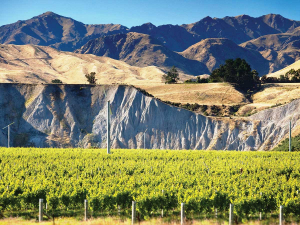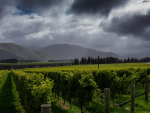Marlborough’s flowering in late 2022 was variable, due to cool weather, but Mark Allen of Mark Allen Vineyard Advisory is seeing a good average crop load in Sauvignon Blanc vineyards, and expects yields to be average or slightly above.
In a good year he expects to see 80 berries per bunch, compared to 50 berries per bunch in a low yielding year, “which is driven by temperature over flowering”. Many of his counts this year are well into the 80s, and he’s also seeing plumped up berries, due to an abundance of rain, “which is what happened last year”.
Like most of the country’s wine regions, Marlborough has been battling disease pressure, with plenty of rain over the growing season. According to VineFacts, the region had 221mm of rain between 1 September and 10 January, including 43.2mm between 4 and 10 January. VineFacts reports 12 botrytis infection periods by mid-January, compared to a typical four, “so they have a really high pre-harvest risk”, says Mark, while noting that growers have been vigilant with spraying and canopy management, with many getting in early with leaf plucking to mitigate the risk. Downy mildew had potential to cause problems, but “hasn’t reared its ugly head”, he says, noting that it’s “just by the skin of their teeth” that Marlborough growers avoided it.
There’s been a jump in the number of growers using mechanical shaking to reduce botrytis risk, with some companies making it mandatory, says Mark, a long-term advocate for the process. Shaking helps remove trash and small green aborted berries, but also impacts on skin thickness, helping combat rot, he says. “Every block we monitor is 50% better at least with Sauvignon Blanc, so that’s huge.” However, a shortage in harvester and tractor drivers is curtailing the ability of some to get that and other key work done. “Most vineyards are 10-20% down on operators so there’s a lot of prioritising.”
Labour is the biggest issue in Marlborough this growing season, Mark says, flagging the large proportion of inexperienced Recognised Seasonal Employer scheme workers here for the summer season. While some are coming up to speed rapidly, a vineyard manager he spoke to in January told him that he needs considerably more people to complete wire lifting this year adding extra cost and time.Again that is seeing growers take a strategic approach, with some trimming after the second wire lift “simply to get through the vineyard in time for mechanical leaf plucking”, says Mark.
New trimming and leaf plucking machines that blow and suck at the same time are a saving grace, allowing them to get across the ground much faster, he adds. “They are doing a fantastic job of opening up the canopy”.
The region has had normal heat units, but has lacked sunshine - “the cheapest fungicide in the world” - with few classic blue-sky days to dry out vines and kill off spores. That’s also likely to push the season out, says Mark. “And if the crop is quite heavy that will push it out as well.” It will be a little bit of a “knife edge season” towards the end, Mark says. “An Indian summer will be magnificent. That would be great.”














